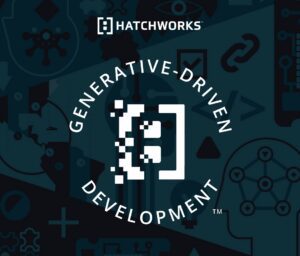You’re wondering how to choose a software development company. A daunting task when you consider just how many options are on the market.
Do you go offshore and risk quality?
Do you go to a boutique agency that will never be able to scale as your projects do?
Do you look to a digital transformation giant and pay an astronomical price?
Or do you go nearshore and see if the rumors about its cost-effectiveness and top tier talent are true?

And even once that choice is made, how do you find the one software development firm that’s able to not only speak code but also understand your unique needs, and how you want to meet them? That attention to detail should extend to the needs and desires of your customer as well.
This guide and checklist will help.
All you need to do is follow the 8 steps below and measure each software development company you’re considering against the downloadable checklist at the end.
Because a critical decision like this deserves a proven process.
In every section, you’ll see a pin (📌). The pin is there to signal a key learning. If that’s the only thing you read, you’ll still see value from the piece.
Step 1. Understand Your Software Development Needs
📌 Figure out what you’re building, if it’s the right project to outsource, the objectives you’re reaching for, and the timeline you’ll follow.
When you’re on the hunt for a software development outsourcing company, you need clarity over the project you’re outsourcing, the expectations you’ll set, and the objective you’re trying to reach.
So, the first step is to get a clear picture of what you’re developing.
Are you building a:
- sleek web platform
- dynamic mobile app
- custom software that doesn’t fit the usual mold?
Knowing this will direct the type of software development company you look for.
Let’s talk goals. What’s the business problem you’re aiming to solve with this software?
Knowing this helps you communicate your vision and ensures everyone’s rowing in the same direction, internally and externally.
Another key consideration is if this is the right project to outsource or if you’d be better off building it with an internal team, and maybe outsourcing something else on your product roadmap.
Outsourcing can give you access to specialists who live and breathe software development, which can be especially useful when your project is complex or outside your team’s core skills. So it’s important you don’t choose a project an internal team could or should handle.
We have an entire guide on how to determine if you should build or buy software. Check it out if that’s a concern.
If outsourcing, come into your search with an idea of a timeline. When do you need it done and what project milestones are important?
We recommend documenting this all in one place so that you can run through it with your shortlist of software developers at a later point.
Step 2. Think about Budget, Time Zones, and Language
📌Where your software development company works from has an impact on cost and is just as important as the capabilities they have.
Sure, you need a team with the right skills. But you also need the experience of working with them to be seamless and affordable.
And if you don’t want to spend an arm and a leg on a boutique software development company but you want the same level of quality, expertise, and service then you should look to Nearshore Software Development providers.
For the US this means looking to our neighbors in Latin America (LATAM).
It also means they’ll be in a similar time zone to you. Aligning time zones means your day-to-day operations can sync up nicely for more effective collaboration, communication, and problem solving.
That clear, continuous dialogue is the cornerstone of any successful project. And when language barriers are low, clarity and productivity are high.
So given that, how important is it to you that your developers speak English fluently? We’d argue, very. LATAM developers are highly educated not just in software programming languages but in English.
Out of Central American countries, Costa Rica is the most proficient in English but generally speaking, Central and South America collectively has high levels of proficiency.
How Latin American Nearshore Software Development Reduces Costs
Nearshore software development in Latin America offers a sweet spot for US businesses looking to cut costs without compromising on quality. Plus, Latin America is rich with tech talent. Countries like Brazil, Mexico, and Argentina are brimming with skilled developers who are up-to-date with the latest tech trends. At HatchWorks we make sure our LatAm based developers stay on top of emerging technologies and trends by offering them continuous development opportunities. They get:- Monthly, employee-led lunch & learns
- Access to Communities of Interest (COIN)
- A Udemy subscription
- $2k/year to spend on relevant learning and development
| Feature | Nearshore (LatAm) | Offshore (Asia) | Onshore (local boutique agencies) |
|---|---|---|---|
|
Costs by hourly rates
|
$35 - $70
|
$20 - $45
|
$80 - $140
|
|
Pros
|
Cost-effective
Easy collaboration (same time zone)
Top tech talent
|
Cost-effective
|
Top tech talent
Easy to collaborate with due to proximity
|
|
Cons
|
May have minor cultural differences
|
Different time zones can negatively impact communication and progress
May lack English proficiency
|
Doesn’t scale well
|
Step 3. Assemble a List of Potential Software Development Companies
📌Ask your network and look to platforms and sites that showcase software development companies to come up with a list of potential software development providers.
You know your project needs and goals, so it’s time to start looking for a top software development outsourcing company that can fulfill them.
Here’s how to make the process more manageable:
- Ask peers and colleagues for recommendations. Who are the best custom software development companies they’ve ever worked with? Who should you avoid?
- Use platforms like Clutch or GoodFirms to find custom software development companies. These sites provide rankings and reviews for thousands of software development companies. Odds are, the right software development company is on there.
- LinkedIn can be a goldmine. Look for companies that share insightful content and engage with their community.
- Attend webinars, virtual conferences, or local meetups. These can double as networking events that lead you to your next development partner.
- See who’s building the software you admire. Sometimes the best way to find talent is to look at who’s already excelling in your field.
Remember, this list is your starting point. You’ll narrow it down as you align potential partners with your specific needs.
📕 Need a little more guidance on hiring development teams? Check out our article: Hiring a Development Team – Everything You Need to Know.
Step 4. Narrow that List Down to Software Companies with Agile Frameworks and Robust Methods
📌Your ability to get great results within budget and within your ideal timeline largely depends on if your software development provider follows an Agile framework and applies robust methods.
You need a team of developers who have agile development methodology, can adapt to changing needs, and offer advice on the best way forward.
So as you’re sifting through your list of potential software development partners, focus on those who embrace Agile frameworks and use robust methods. And cull the rest.
Here’s why:
- Agile for efficiency and scalability: Agile frameworks are all about being nimble and responsive. They allow for rapid iteration and continuous feedback, which can significantly reduce time-to-market. In an industry where speed is often as crucial as quality, this approach can be a game-changer.
- Robust methods for consistent quality: Look for companies that have robust methods in place, ensuring that every piece of code, every feature, and every update meets a high standard of quality. This means having a systematic approach to development, from code reviews to testing protocols, ensuring that quality is not just a one-time achievement but a continuous commitment.
At HatchWorks, we created Generative-Driven Development™. This development methodology guarantees we stay agile in our approach and follow proven frameworks we know will work.
And that translates to projects that are always on time, on budget, and high quality.
What is Generative-Driven Development™?
See how HatchWorks is leading the way in AI-powered software development.
Our Generative-Driven Development™ leverages cutting-edge AI to optimize your software engineering projects.
Discover the difference on our page.

Choosing a software development company isn’t just about who can build your solution; it’s about who can build it right, with an eye on the future and a foundation in proven, efficient methodologies.
Our Method in Action: A Case Study
HatchWorks’ collaboration with a leading healthcare company, AdventHeatlh showcases the power of the Built Right Method in transforming project outcomes while staying on budget and on time.
This particular project was in four parts with a main focus on transitioning their system from a centralized to a decentralized model within a tight three-month deadline.
Another was the implementation of an electronic medical record system, crucial for 80% of hospitals in the US. And despite AdventHealth being behind schedule by 15% just three weeks before the go-live date, HatchWorks’ program manager stepped in to help them get back on schedule within one week.
At the end of the project, AdventHealth’s Director of Program Management said,
HatchWorks was a great partner. They always met the deliverable dates that I gave them. They made sure that we stayed within our budget, and they were flexible in working with us.”
Step 5. See How Each Software Company Approaches AI
📌Narrow your list of providers even further by seeing if they have an AI-enabled software development team, or as we at HatchWorks call them, ‘hyper-enabled teams’.
Now that your list of potential software development partners is getting smaller, you can get closer to your ideal match by judging how each company handles, or doesn’t handle, AI.
You’ll want to pay special attention to how they integrate AI into their development software development process too. This integration is key to unlocking new levels of efficiency and innovation.
📕Read our article on Generative AI Use Case Trends Across Industries: A Strategic Report to learn more.
AI streamlines complex tasks, automates repetitive processes, and brings a level of precision that’s hard to achieve manually. This leads to a significant reduction in development time and costs.
With AI, teams can focus on creative problem-solving and innovation while accelerating delivery.
In fact, statistics show developers are 55% faster with AI assistance.
This is good for software development companies and good for the clients that use them.
Look at your list. Is there anyone who isn’t actively talking about how they use AI? That’s a red flag.
Step 6. Consider Their Track Record through Testimonials, Case Studies, and Reviews
📌 A company’s past performance is often indicative of what you can expect for your project. So, take the time to scrutinize their track record thoroughly.
When you go to buy something online one of the first things you do before purchasing is look at the reviews, right?
Always do the same when shopping for the right software development partner.
Look into testimonials they have on their website, case studies they showcase, and reviews from third party sites like Clutch.
Here’s what to focus on:
- Testimonials and reviews: Look beyond the surface praise. Seek testimonials that speak to specific strengths, such as problem-solving abilities, adherence to deadlines, and communication skills. Reviews should give you a sense of their reliability and the quality of their work.
- Case studies: Dive into their case studies. They provide context to their achievements. What challenges did they face? How did they overcome them? What were the tangible results? This analysis can reveal a lot about their approach and effectiveness.
- Third-party reviews: Platforms like Clutch or Trustpilot offer unbiased opinions. These reviews are often more detailed and can provide a clearer picture of what it’s like to work with the company.
Make notes as you go through them next to the names of each potential software development outsourcing partner. These notes will help you make the final choice later on. At this point, you may even feel you know which company you’ll go for.
But there’s one more key step to follow before you make your choice.
Step 7. Speak to Each Software Company on Your Shortlist 1-1
📌Your interviews with each potential software development vendor allows you to get a glimpse into what it would be like to work with them on a regular basis.
Your shortlist needs to get shorter still. And this next phase of finding a competent, focused, and reliable software development company to partner with requires you speak to your remaining few contenders.
To make sure these conversations reveal what you need them to so that you can make your final choice you should ask the right questions to see if there’s a cultural fit, ensure they really do have the focus and skills you need, as well as uncover if they feel like a true partner in this project.
When you have your 1-1 call, be sure to ask about their:
- experience with projects similar to yours
- approach to tackling challenges, and how they handle changes in scope
- project management tools and communication practices
- technical competencies
- examples of their problem-solving in action
- use of AI
These conversations are pivotal in determining which company is the right fit for your project, not just in capability but in collaboration and shared vision.
Step 8: Time to Choose a Software Development Company – Making Your Decision (+ a Foolproof Checklist)
📌Review the notes you’ve made on your final contenders for software development and see who lines up best. Use the checklist as you go.
You’ve understood your software needs, thought about the advantage nearshore development can have, assembled a long list, shortened that list off the back of due diligence, and spoken to your top choices.
And now it’s time to make your choice.
While the 7 steps above have ensured you know exactly how to choose a software development company, this checklist consolidates those steps and provides additional subtasks to help you arrive at the right decision.
The Right Software Development Company: HatchWorks AI
Who you choose to work on your next development project really does matter.
Because with the right software development partner, your project will go beyond expectations.
HatchWorks AI is a leading AI software development agency and partner based in Atlanta, GA, pioneering next-generation software development through our Generative-Driven Development™. We build AI native solutions.
We combine local U.S. expertise with the affordability and scale of Nearshore outsourcing, ensuring alignment with U.S. time zones and delivering a comprehensive suite of AI-powered software development services.
Our approach accelerates delivery, drives measurable ROI, and positions our clients for long-term success in an AI-driven world.
Want to bring HatchWorks to the top of your list and choose us as your go-to custom software development company?
We can get your project off the ground in 2 weeks time with the best talent LATAM has to offer.
Frequently Asked Questions
1. What does choosing a software development company mean for my business?
Choosing a software development company means finding a software development partner or development partner that supports your business processes and aligns with your project requirements. By choosing a software development company that understands your objectives and uses the right development process and technology stack, you’re more likely to achieve a successful project and a high-quality software solution.
2. How do I choose a software development company that fits my project scope and timeline?
Start by clarifying your project scope, project requirements, and desired timeline. Then look for software development companies that have a strong development process, proven project management practices, and a portfolio of previous projects. Consider those that use an Agile development methodology, communicate openly, and offer engagement models like a fixed price model if that suits your needs. This approach helps ensure you and the provider are aligned and can deliver on time.
3. How do time zone differences affect working with a potential software development partner?
Time zone differences can impact real-time communication and collaboration. Choosing a development company with similar working hours makes it easier for your software development team and outsourcing partner to stay on the same page. Nearshore options can reduce delays and improve the speed of decision-making compared to offshore software development models.
4. How can I verify a software development company’s credibility and experience?
Check their company’s portfolio, review past projects, and look for feedback from previous clients. Third-party review platforms like Clutch can provide unbiased insights. Also, assess whether they can handle various programming languages, protect intellectual property, and maintain robust business processes. Reliable software development companies typically have strong development methodologies and clear examples of successful outcomes.
5. Should I consider offshore, onshore, or nearshore when I choose a software development partner?
Onshore providers often deliver high quality but at a higher cost. Offshore companies may reduce costs but can present challenges like time zone differences and communication barriers. Nearshore development companies strike a balance by offering cost-effective services, top-tier talent, and alignment in working hours. This combination often makes nearshoring an efficient choice for mobile app development, web development, and other software development projects.
6. How do I ensure the software development team understands my project requirements and uses proper security measures?
Look for a development partner that offers thorough discovery sessions to fully understand your project requirements. Confirm that they follow a proven development process, maintain proper security measures, and protect intellectual property. A reputable software development firm will use effective communication, involve business analysts when needed, and keep you informed throughout the project development cycle.
7. What role do fixed price models and flexible engagement options play in choosing a software development partner?
Fixed price models offer cost predictability, which can be helpful if you have a clearly defined project scope. More flexible engagement options allow you to adapt as your development project evolves. Regardless of the model, choose a software development partner that aligns their services with your changing needs, follows a suitable development methodology, and can scale the development team as necessary.
8. How important is intellectual property protection and technical expertise when I choose a software development partner?
Protecting your intellectual property is critical. A trusted software development partner will have contracts and protocols in place to safeguard your IP. They should also demonstrate technical expertise in relevant programming languages, a suitable technology stack, and a proven development process. This combination helps ensure your ideas remain secure and that you receive high-quality software development work.
9. Can working with outsourcing companies improve communication and team alignment?
Yes. Many outsourcing companies, including software outsourcing companies, leverage communication tools and follow Agile development methodologies to keep everyone aligned. The right development partner will streamline communication between your internal team and the external software development team, ensuring all stakeholders remain on the same page.
10. How do I know if I’ve found the best software development company for my needs?
You’ve likely found the best software development company if they meet your project requirements, fit your budget, align with your timeline, and show a strong record of delivering quality projects. They should demonstrate expertise in relevant areas (such as web development or mobile app development), protect your intellectual property, offer a dedicated development team, and approach challenges with a reliable development methodology. Ultimately, the right partner will be focused on your long-term success.
We’re ready to support your project!
Instantly access the power of AI with our AI Engineering Teams.




